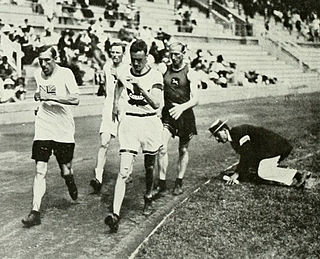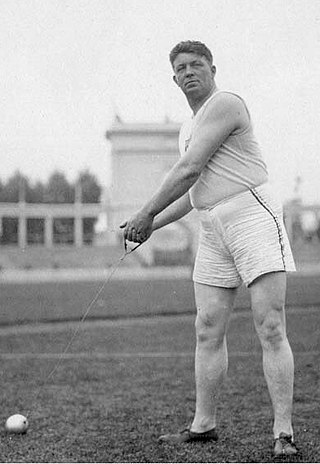
The discus throw, also known as disc throw, is a track and field sport in which the participant athlete throws an oblate spheroid weight — called a discus — in an attempt to mark a further distance than other competitors. It is an ancient sport, as demonstrated by the fifth-century-BC Myron statue Discobolus. Although not part of the current pentathlon, it was one of the events of the ancient Greek pentathlon, which can be dated back to at least 708 BC, and it is part of the modern decathlon.

The decathlon is a combined event in athletics consisting of 10 track and field events. The word "decathlon" was formed, in analogy to the word "pentathlon", from Greek δέκα and ἄθλος. Events are held over two consecutive days and the winners are determined by the combined performance in all. Performance is judged on a points system in each event, not by the position achieved. The decathlon is contested mainly by male athletes, while female athletes typically compete in the heptathlon.

The 1904 Summer Olympics were an international multi-sport event held in St. Louis, Missouri, United States, from 1 July to 23 November 1904. Many events were conducted at what is now known as Francis Field on the campus of Washington University in St. Louis. This was the first time that the Olympic Games were held outside Europe.
At the 1904 Summer Olympics, nine swimming events were contested. The 1904 swimming competition was the only time in Olympic history that racing distances were measured in yards. The competition was held September 4–6, 1904. There was a total of 32 participants from 5 countries competing. The 10 events at the swimming competitions were held at a man-made lake that was used for life-saving exhibitions by the coast guard.

A pentathlon is a contest featuring five events. The name is derived from Greek: combining the words pente (five) and -athlon (competition). The first pentathlon was documented in Ancient Greece and was part of the Ancient Olympic Games. Five events were contested over one day for the Ancient Olympic pentathlon, starting with the long jump, javelin throwing, and discus throwing, followed by the stadion and wrestling. Pentathletes were considered to be among the most skilled athletes, and their training was often part of military service—each of the five events in the pentathlon was thought to be useful in war or battle.

The 1904 Summer Olympics were held in St. Louis, Missouri, United States from July 1 to November 23, 1904, as part of the St. Louis World's Fair.
The men's medley relay was run for the first time at the 1908 Summer Olympics in London. The event consisted of 1600 metres being run by four athletes per team. Unlike the later 4 × 400 metres relay, however, the athletes had different distances to run. In the medley, the first two runners each ran 200 metres. The third runner ran 400 and the fourth ran 800. The competition was held on 24 and 25 July 1908. 28 runners from 7 nations competed. NOCs could enter one team of four, with four reserves.

Athletics has been contested at every Summer Olympics since the birth of the modern Olympic movement at the 1896 Summer Olympics. The athletics program traces its earliest roots to events used in the ancient Greek Olympics. The modern program includes track and field events, road running events, and race walking events. Cross country running was also on the program in earlier editions but it was dropped after the 1924 Summer Olympics.
The men's 3500 metre walk race was held for the only time at the 1908 Summer Olympics in London. The competition was held on Tuesday, July 14, 1908. It was held in two rounds. There were three heats in the first round, with the top three in each heat advancing to the final. 25 racewalkers from eight nations competed. NOCs could enter up to 12 athletes.
The men's 10 miles walk race was held at the 1908 Summer Olympics in London. This was the only time the event was held. The competition was held on Thursday, July 16, 1908, and on Friday, July 17, 1908. The competition was held in two rounds. There were two heats in the first round, with the top four in each heat advancing to the final. 25 race walkers from eight nations competed. NOCs could enter up to 12 athletes.

The men's 10 kilometres walk was a track and field athletics event held as part of the Athletics at the 1912 Summer Olympics programme. It was the second appearance of racewalking, which had debuted at the previous games with the 10 mile and 3500 metre walks. The 10 kilometre was the only racewalking event in 1912. The competition was held on Monday, July 8, 1912, and on Thursday, July 11, 1912. Twenty-three racewalkers from twelve nations competed. NOCs could enter up to 12 athletes.

At the 1912 Summer Olympics, the men's individual cross country race was held as part of the athletics programme. It was the first appearance of the event. The competition was held on Monday, July 15, 1912. Forty-five runners from nine nations competed. NOCs could enter up to 12 athletes.
The men's 3 kilometres walk event was part of the track and field athletics programme at the 1920 Summer Olympics. The competition was held on the track on Friday, August 20, 1920, and on Saturday, August 21, 1920. Twenty-two race walkers from twelve nations competed.
The men's 10 kilometres walk event was part of the track and field athletics programme at the 1920 Summer Olympics. The competition was held on Tuesday, August 17, 1920, and on Wednesday, August 18, 1920. Twenty-three race walkers from 13 nations competed.

The men's discus throw event was part of the track and field athletics programme at the 1920 Summer Olympics. The competition was held on Saturday, August 21, 1920, and on Sunday, August 22, 1920. 17 discus throwers from eight nations competed. No nation had more than 4 athletes, suggesting the limit had been reduced from the 12 maximum in force in 1908 and 1912. The event was won by Elmer Niklander of Finland, the nation's second consecutive victory in the men's discus throw. Armas Taipale, the winner in 1912, took silver to become the second man to win multiple medals in the event. Gus Pope took bronze, continuing the American streak of podium appearances at all six discus competitions to date.

The men's hammer throw event was part of the track and field athletics programme at the 1920 Summer Olympics. The competition was held on Wednesday, August 18, 1920. 12 throwers from 5 nations competed; four from Sweden, four from the United States, two from Canada, one from Great Britain, and one from Finland. No nation had more than 4 athletes, suggesting the limit had been reduced from the 12 maximum in force in 1908 and 1912. The event was won by Patrick Ryan of the United States, the nation's fifth consecutive victory in the event. Carl Johan Lind took silver, earning Sweden's first medal in the hammer throw. Another American, Basil Bennett, earned bronze.

The men's javelin throw event was part of the track and field athletics programme at the 1920 Summer Olympics. The competition was held on Sunday, August 15, 1920. Twenty-five javelin throwers from twelve nations competed.

The men's discus throw event was part of the track and field athletics programme at the 1924 Summer Olympics. The competition was held on Sunday, July 13, 1924. 32 discus throwers from 18 nations competed. The maximum number of athletes per nation was four. The event was won by Bud Houser of the United States, the nation's fourth victory in the men's discus throw ; the Americans had medalled in each of the Olympic discus throw events to date. Houser had also won the shot put. Vilho Niittymaa took silver, keeping Finland on the podium in the event for the third straight Games. Thomas Lieb gave the United States its second discus throw medal of 1924, with his bronze.

Anita Włodarczyk is a Polish hammer thrower. She is the 2012, 2016 and 2020 Olympic champion, and the first woman in history to throw the hammer over 80 m; she currently holds the women's world record of 82.98 m. She is considered the greatest female hammer thrower of all time.

The men's hammer throw event was part of the track and field athletics programme at the 1936 Summer Olympics. The competition took place on August 3, 1936, with 27 competitors from 16 nations. The maximum number of athletes per nation had been set at 3 since the 1930 Olympic Congress. The final was won by Karl Hein of Germany. The silver medal went to Erwin Blask, also of Germany. They were the first medals for Germany in the event; Germany was also the first country other than the United States to have two medalists in the event in the same Games. Fred Warngård of Sweden took bronze. The United States' eight-Games medal streak in the hammer throw was snapped, with the Americans' best result being William Rowe's fifth place.













